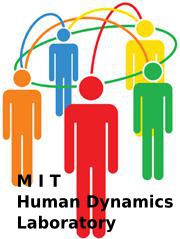Reality Commons
brought to you by the MIT Human Dynamics Lab
Friends and Family Dataset - Publications and Findings
Aharony and colleagues compared different intervention schemes to promote physical exercises: (1) rewarding $5 every 3 days to individuals according to her accumulative exercise time, (2) rewarding $5 plus allowing individuals to see their buddies' exercise time reciprocally, and (3) rewarding friends according to accumulative exercise time thus introducing peer pressure [Aharony et. al., 2011]. Scheme 3 was twice as effective as scheme 2, and scheme 2 is better than scheme 1. This suggests that more intervention schemes should be simulated and tested.
Pan and collaborators could predict whether an individual will install a mobile phone application based on 1) the number of his friends, (2) how many of those friends to whom he called or sent short messages, (3) what percentage of people he passed by, and (4) what percentage of people in his department installed the application [Pan et. al., 2011a], based on survival analysis. We believe a stochastic process model such as the susceptible- infectious-recovery model in epidemiology or a voting model in studying opinion dynamics could predict not only who will install an application, but also the time that it would be installed.
According to Pan and collaborators, the higher a person's current income, the more evenly a person distributes his time among his contacts [Pan et. al., 2011b]. Further, increased income of a person indicates more even distribution of time among contacts, decreased income indicates less even distribution, and previous income has no correlation with the distribution of the individual's time. This seems to suggest that the causal relationship between wealth and interaction diversity, as described by Burt [Burt, 1995], requires further investigation against the human behavioral data tracked by mobile phones.
Moturu and colleagues [Moturu et. al., 2011] confirmed a subject on average slept 7 hours in days of good mood and 6.4 hours in days of bad mood. (Null hypothesis "sleep duration in good mood follow the same probability distribution as sleep duration in bad mood" is rejected with p < 0.01.) They also confirmed that the subjects with less than average sleep met people more infrequently (less sociable) in the day before and in the day after (p < 0.01). All findings indicate that we can correlate mood and sociability from sleep duration, and that we may even able to improve mood, sociability, or sleep by manipulating the other two.
Focusing on structural indices, Staiano and collaborators [Staiano et. al., 2012] found that: a) a person's social network structure as captured by his/her mobile phone's activity logs can reveal big-5 personality traits better than both individual self-reports and individual usage data; and that b) predictive power is sensitive to specific cell-phone activity/personality trait combinations. In particular, this work reveals that: a) centrality and triadic ego-network measures on proximity network are predictive of how Agreeable the person is (75% accuracy vs. 65% accuracy from surveys); b) centrality measures of combined proximity and voice call network tell how Self-conscientious he/she is (77% vs. 67%); c) triadic and transitivity measures on proximity networks are predictive of Extraversion (80% to 61%); d) centrality measures of voice call network are predictive of Neuroticism (74% vs. 63%); and, e) transitivity measures on the combined proximity/voice-call network are predictive of Openness (77% vs. 73%). In short, friends might lie to you, but they don't do so about you.
- [de Montjoye et. al., 2013] Yves-Alexandre de Montjoye, Jordi Quoidbach, Florent Robic, Alex Sandy Pentland, "Predicting people personality using novel mobile phone-based metrics". Social Computing, Behavioral-Cultural Modeling and Prediction (2013).
- [Altshuler et. al., 2012] Altshuler, Y. and Fire, M. and Aharony, N. and Elovici, Y. and Pentland, A, "How Many Makes a Crowd? On the Correlation between Groups' Size and the Accuracy of Modeling", Proceedings of the International Conference on Social Computing, Behavioral-Cultural Modeling and Prediction, 43-52, 2012
- [Staiano et. al., 2012] Jacopo Staiano, Bruno Lepri, Nadav Aharony, Fabio Pianesi, Nicu Sebe, and Alex Pentland. Friends don't lie - Inferring Personality Traits from Network Structure. In UbiComp '12 Proceedings of the 2012 ACM Conference on Ubiquitous Computing, pages 321-330. ACM New York, NY, USA 2012. ISBN: 978-1-4503-1224-0.
- [Altshuler et. al., 2011b] Altshuler, Y. and Aharony, N. and Pentland, A. and Elovici, Y. and Cebrian, M., "Stealing Reality: When Criminals Become Data Scientists (or Vice Versa)", IEEE Intelligent Systems, 26(6), 22-30, 2011
- [Altshuler et. al., 2011a] Altshuler, Y. and Aharony, N. and Fire, M. and Elovici, Y. and Pentland, A., "Incremental learning with accuracy prediction of social and individual properties from mobile-phone data", arXiv preprint arXiv:1111.4645, 2011
- [Aharony et. al., 2011] Nadav Aharony, Wei Pan, Cory Ip, Inas Khayal, and Alex Pentland. Social FMRI: Investigating and shaping social mechanisms in the real world. Pervasive and Mobile Computing, 7(6):643-659, 2011.
- [Pan et. al., 2011a] Wei Pan, Nadav Aharony, and Alex Pentland. Composite social network for predicting mobile apps installation. In Wolfram Burgard and Dan Roth, editors, AAAI. AAAI Press, 2011a.
- [Pan et. al., 2011b] Wei Pan, Nadav Aharony, and Alex Pentland. Fortune monitor or fortune teller: Understanding the connection between interaction patterns and nancial status. In SocialCom/PASSAT DBL [2011], pages 200-207.ISBN 978-1-4577-1931-8.
- [Moturu et. al., 2011] Sai T. Moturu, Inas Khayal, Nadav Aharony,Wei Pan, and Alex Pentland. Using social sensing to understand the links between sleep, mood, and sociability. In SocialCom/PASSAT DBL [2011], pages 208-214. ISBN 978-1-4577-1931-8.


